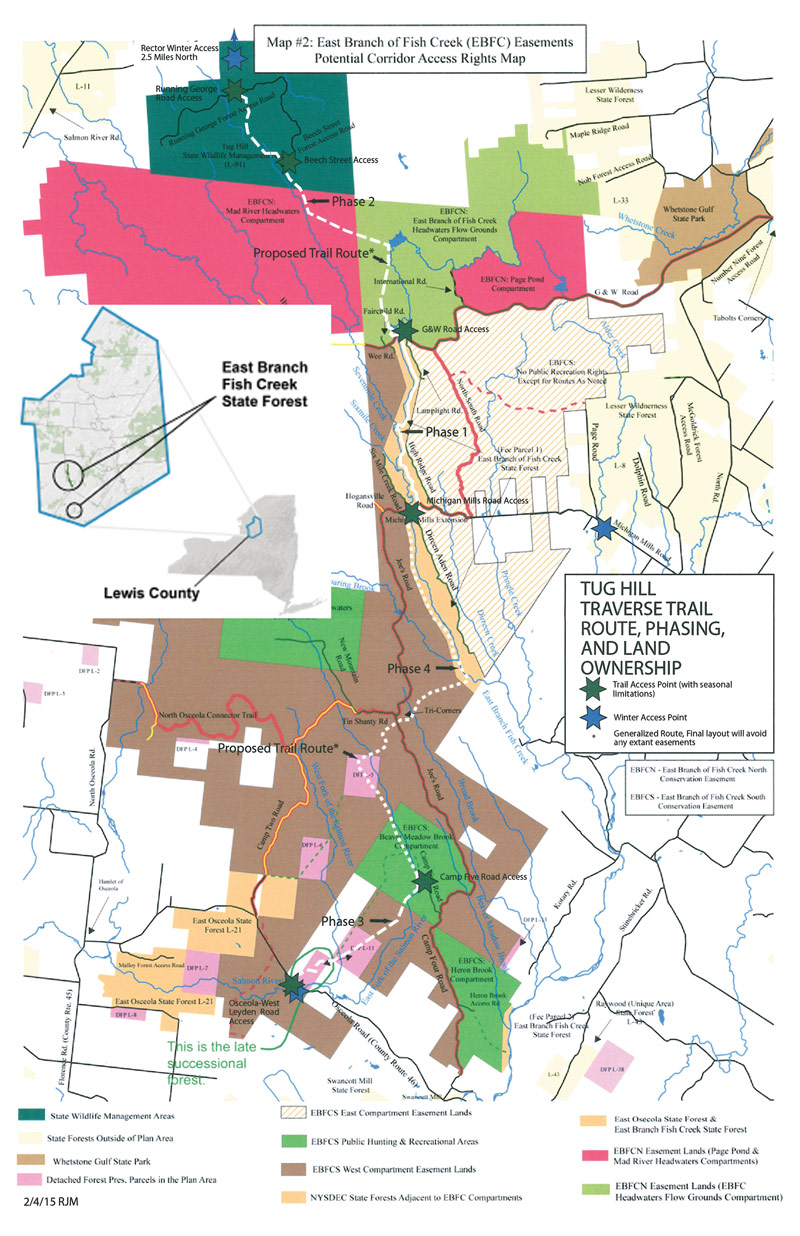It’s not truly wilderness, though the term “Lesser Wilderness” is sometimes used to compare the Heart of Tug Hill to the vaster wilderness of the nearby Adirondacks. The area consists of “core forest” with over 170,000 acres of unbroken forest land, wetlands, ponds, and headwater streams. Not only is this landscape vital to a multi-state wildlife corridor, but it also supports our regional traditions of forestry, hunting and hunt camps, fishing, hiking, bird watching, and snowmobiling.

Numerous rivers, whose headwaters are located in the Heart of Tug Hill rely on the forest’s health and resilience to sustain their flows throughout the summer, as well as absorbing heavy rainfalls. Much of Tug Hill revolves around these amazing landscapes and include the Salmon, Mad, and Deer Rivers, as well as the Sandy Creeks and the East and West Branches of Fish Creek.
Recent research has once again documented the importance of forestlands and their associated wildlife habitat. In 2019, the Tug Hill Chapter of Trout Unlimited found unique strains of brook trout in portions of some Tug Hill headwaters streams. These brook trout are genetically distinct, showing little evidence of introduction of non-native or hatchery-raised stock.
During the same period, research by The Nature Conservancy concluded that the Heart of Tug Hill faces development pressure that could fragment and disrupt the ecological health of the region. In short, it’s an area with an urgent need for thoughtful, accelerated and long-term conservation efforts.
There’s reason for guarded optimism, however. Landowners are asking for our assistance and funding may become available thanks to ongoing discussions at the state and federal levels to voluntarily conserve 30% of the U.S. land base and waters by 2030 (termed 30 x 30).
The 30 x 30 initiative recognizes that land conservation is not keeping pace with growing threats to our lands, waters, wildlife, and ways of life across the country. The Land Trust Alliance (the national conservation organization that provides technical assistance to local land trusts) has stressed the critical nature of this voluntary effort.
National Audubon notes its importance, too. North America has lost three billion birds due to climate change and habitat loss—29% of its bird population—since 1970.
Perfect Timing
The majority of landowners in the Heart of Tug Hill are elderly and many face the choice of selling their land, ideally protected, or passing it on to the next generation. Because of this, when combined with development pressure, the next ten years will define what Tug Hill looks and feels like.
Our task, therefore, is to make sure we have the capacity to seize opportunities presented like the 30 x 30 initiative and assist these families when they ask for help. That’s one of the reasons we launched the Tug Hill FOR Tomorrow Campaign. A huge thanks to so many of you who have already contributed.
Together, we can support our region’s desire to balance future development with the protection of the farms, forests, waters, and wildlife habitats that define us.
“It’s so peaceful out there. I love that we are working together to create a trail that is unique to Tug Hill.”
— Nancy Grisham
WANT TO HELP MAKE HISTORY?
Come join us and create the Tug Hill Traverse Trail
 This summer and fall, we have a number of community trail workdays planned to continue work on the 20-mile long Traverse Trail, in forested portions of the towns of Osceola, West Turin, and Montague (lands we call the Heart of Tug Hill).
This summer and fall, we have a number of community trail workdays planned to continue work on the 20-mile long Traverse Trail, in forested portions of the towns of Osceola, West Turin, and Montague (lands we call the Heart of Tug Hill).
They’re a fun way to spend some time with family, friends, and co-workers; get outside; hear some birds; and get your hands dirty. Trail work consists of pruning branches and shrubs, building stream crossings, and putting up trail markers.
You’ll want to wear sturdy shoes and appropriate clothing for working in the woods, and bring pruners if you have them. We will provide snacks and water and recommend you bring a sack lunch.

